You’ll choose 3D printing for manufacturing tools because it cuts production time from weeks to same-day delivery while reducing costs by 60-80% compared to traditional methods. You can create complex geometries impossible with conventional machining, iterate designs instantly based on feedback, and eliminate expensive molds and dies. You’ll also minimize material waste, reduce inventory needs, and customize tools for specific operations. These advantages position 3D printing as essential technology that’ll transform your manufacturing capabilities.
What Is 3D Printed Manufacturing Tooling?
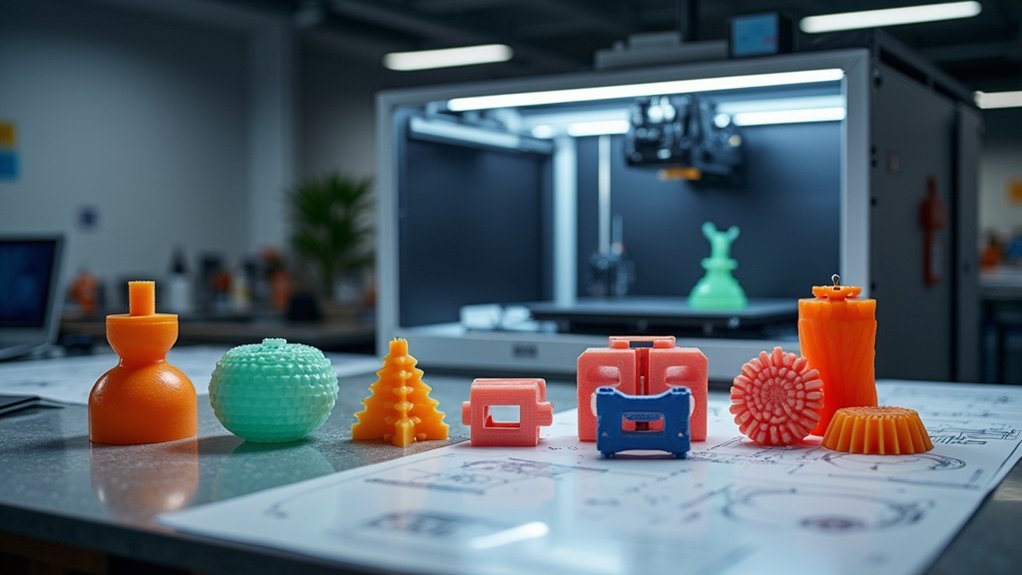
Revolutionary advancements in additive manufacturing have transformed how companies produce essential manufacturing components.
3D printed manufacturing tooling creates tools, fixtures, templates, dies, molds, and jigs through precise layer-by-layer deposition based on digital models.
This innovative approach replaces traditional manufacturing methods with faster, more efficient solutions. You’ll find that 3D printed tooling offers unmatched design flexibility, allowing you to create intricate shapes and customized solutions that weren’t possible before.
The technology enables you to produce complex geometries without the constraints of conventional machining or molding processes.
You’ll experience significant cost savings by eliminating expensive redesigns and reducing capital expenditure.
The streamlined production process cuts lead times dramatically, helping you respond quickly to changing manufacturing requirements while maintaining high-quality standards throughout your operations.
Traditional vs. Additive Manufacturing for Tool Production
Understanding these benefits becomes clearer when you compare 3D printing directly with conventional manufacturing approaches.
Traditional manufacturing processes require extensive lead times and substantial upfront investments for tooling, while additive manufacturing produces complex tools rapidly, accelerating your prototyping and market entry.
You’ll discover enhanced design flexibility with 3D printing, creating intricate geometries impossible through conventional methods.
Traditional approaches waste material through subtractive processes, whereas additive manufacturing uses only necessary materials, reducing waste considerably.
Production costs favor 3D printing for small batches, eliminating expensive tooling requirements of injection molding.
You’ll also reduce storage expenses by producing tools on-demand rather than maintaining large inventories.
This shift transforms your manufacturing efficiency and cost structure fundamentally.
Rapid Prototyping Capabilities for Custom Tools
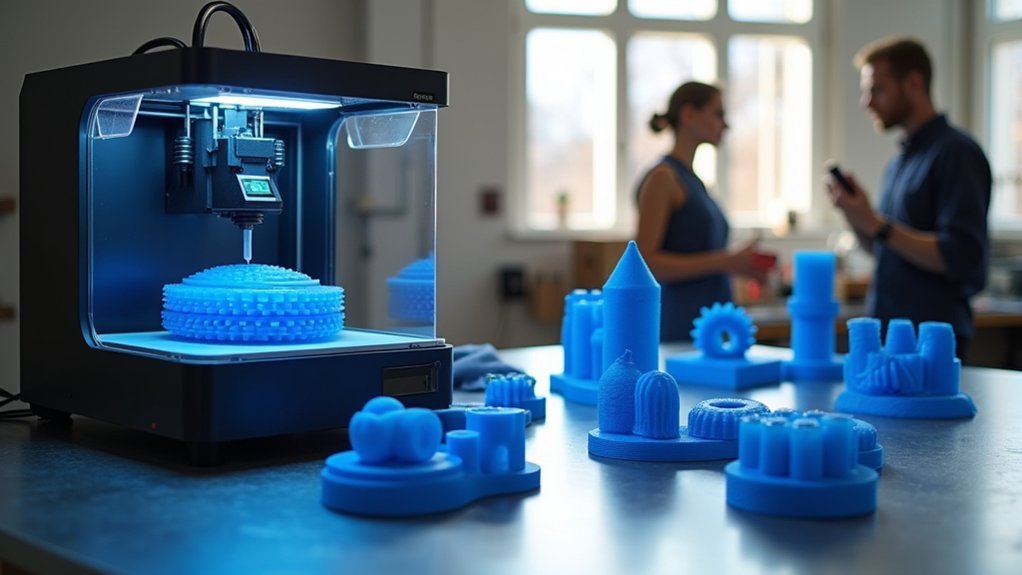
When you need custom tools fast, 3D printing transforms weeks-long prototype development into same-day reality.
You’ll dramatically cut lead times from traditional manufacturing methods that often require extensive setup and tooling processes.
3D printing delivers three key advantages for rapid prototyping:
- Instant iterations – You can modify designs and print new versions within hours based on testing feedback.
- Complex geometries – You’ll create intricate tool designs impossible with conventional manufacturing techniques.
- Cost-effective testing – You can prototype multiple design variations without significant financial risk.
You’ll eliminate large inventory requirements since custom tools are produced on-demand.
This rapid prototyping capability lets you test, refine, and perfect your tools in real-time, ensuring peak performance before committing to full production runs.
Cost-Effectiveness of 3D Printed Tooling Solutions
You’ll drastically cut your initial investment when you switch to 3D printed tooling, as there’s no need for expensive molds, dies, or specialized equipment that traditional manufacturing demands.
Your setup costs become minimal since you can produce tools directly from digital files without complex machining operations or lengthy preparation processes.
This means you’re able to start production immediately without the financial burden of large capital expenditures that typically delay project timelines.
Reduced Capital Expenditure
While traditional manufacturing requires substantial upfront investments in expensive molds, dies, and specialized equipment, 3D printed tooling dramatically slashes your capital expenditure by eliminating these costly assets.
You’ll avoid the massive financial burden that typically comes with conventional production methods.
Here’s how 3D printed tooling reduces your capital expenditure:
- Eliminates expensive molds and dies – You won’t need to invest tens of thousands in traditional tooling equipment.
- Minimizes equipment requirements – Your production process becomes leaner with fewer specialized machines.
- Enables cost-effective prototyping – You can test designs without expensive retooling investments.
This shift means you’ll redirect funds from heavy machinery purchases toward innovation and growth, making your manufacturing operation more financially flexible and responsive to market demands.
Lower Setup Costs
Most manufacturers discover that 3D printed tooling cuts setup costs by 60-80% compared to traditional methods, transforming how you’ll approach production planning and budgeting. You’ll eliminate expensive molds and tooling equipment while leveraging rapid production capabilities to reduce downtime during setup phases.
| Cost Factor | Traditional Tooling | 3D Printed Tooling |
|---|---|---|
| Initial Investment | $10,000-$50,000 | $500-$2,000 |
| Setup Time | 2-8 weeks | 1-3 days |
| Material Waste | 40-60% | 5-10% |
The additive process considerably cuts material costs by using only necessary amounts, reducing waste considerably. You’ll create complex geometries without additional tooling modifications, and iterate designs at a fraction of conventional costs. This flexibility transforms your development phase economics while maintaining quality standards.
Design Freedom and Complex Geometries
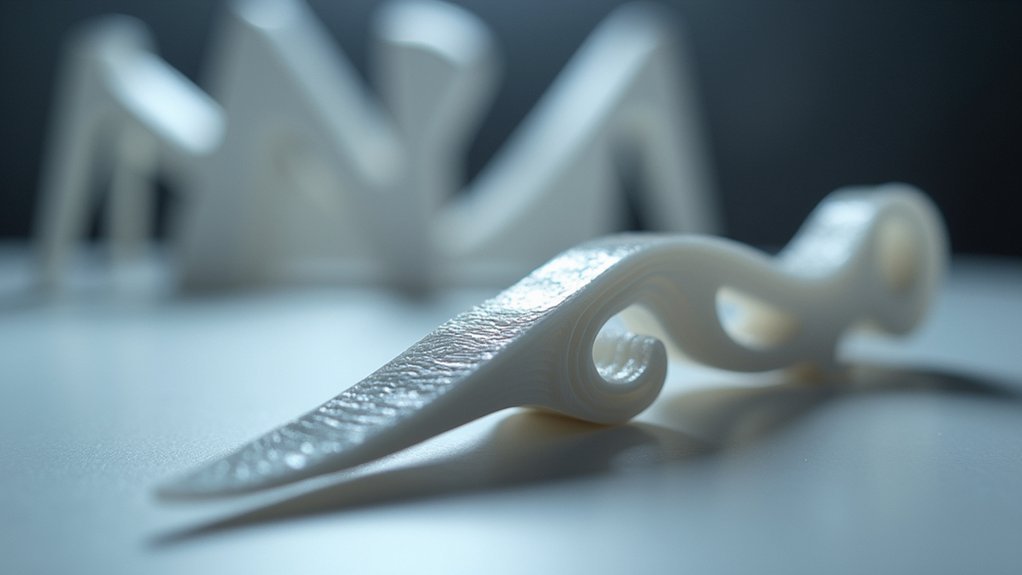
You’re no longer bound by the geometric limitations that constrain traditional manufacturing methods when you embrace 3D printing for tooling applications.
This freedom lets you create tools with unlimited geometric complexity, including internal channels, lattice structures, and interconnected cavities that would be impossible to machine conventionally.
You’ll also discover that rapid design iterations become effortless, allowing you to quickly prototype custom tool solutions tailored to your specific manufacturing needs.
Unlimited Geometric Complexity
When traditional manufacturing methods hit their limits with complex internal structures and intricate geometries, 3D printing breaks through those barriers entirely.
You’ll discover unlimited geometric complexity that transforms how you approach tool design. The design freedom eliminates machining constraints that previously forced compromises in your tool functionality.
You can now create complex structures that were once impossible:
- Internal cooling channels – Design intricate pathways within solid components for ideal temperature control
- Honeycomb lattice structures – Build lightweight yet strong internal geometries that reduce material costs
- Custom conformal surfaces – Create tools that perfectly match unique part geometries without additional tooling
The advantages of additive manufacturing extend beyond complexity.
You’ll produce highly customized components tailored to specific applications while maintaining structural integrity and performance standards.
Rapid Design Iterations
As your manufacturing demands evolve, 3D printing’s rapid iteration capabilities let you refine tool designs in days rather than weeks. You can quickly modify and improve designs based on real-time feedback, eliminating the lengthy delays traditional manufacturing methods impose.
This speed advantage lets you customize designs to meet specific operational demands while maintaining peak performance standards.
Printing allows you to experiment freely with innovative solutions, encouraging bold design choices that enhance production processes. You’ll respond swiftly to market changes and customer needs, gaining a significant competitive edge.
The prototyping phase accelerates dramatically, enabling you to test multiple design variations efficiently. This flexibility transforms how you approach tooling challenges, turning what once required extensive planning into agile, responsive development cycles that keep pace with industry demands.
Custom Tool Creation
Beyond speed improvements, 3D printing reveals unprecedented design freedom that transforms how you approach custom tool creation.
You’re no longer constrained by traditional manufacturing limitations when developing customized designs for your specific production needs.
The creation of complex internal geometries becomes achievable, enabling you to integrate features like cooling channels directly into your tools.
This level of sophistication enhances performance while reducing assembly requirements.
Key benefits of 3D printing for custom tools include:
- Intricate geometries that are impossible with conventional methods
- Lightweight structures that maintain strength and improve handling
- Bespoke solutions tailored to unique manufacturing operations
You’ll discover that complex internal structures and customized features can be seamlessly integrated, supporting innovation while improving your production processes and final product quality.
On-Demand Production Without Minimum Orders
Since traditional manufacturing often requires large minimum order quantities that can strain budgets and create unwanted inventory, 3D printing revolutionizes how you approach tool production by eliminating these constraints entirely.
You’ll produce exactly what you need, when you need it, without meeting arbitrary quantity thresholds. This 3D printing technology transforms your manufacturing workflow through true on-demand production.
You can create single tools or small batches without the financial penalties traditional methods impose. When market demands shift suddenly, you’ll respond immediately by printing specialized tools directly from digital files.
The cost benefits extend beyond eliminating minimums. You’ll reduce material costs since additive manufacturing only uses necessary materials, eliminating waste from subtractive processes.
Low-volume production becomes economically viable, making prototyping and specialized tooling accessible without breaking your budget.
Material Options for Manufacturing Tools
You’ll face critical decisions when selecting materials for your 3D-printed manufacturing tools, particularly choosing between plastic and metal options based on your specific application needs.
Your material choice directly impacts the tool’s durability, performance under stress, and ability to withstand rigorous manufacturing environments.
You can optimize costs by understanding which materials deliver the required mechanical properties without overspecifying for applications that don’t demand premium performance characteristics.
Plastic Vs Metal Materials
When you’re selecting materials for 3D-printed manufacturing tools, the choice between plastic and metal fundamentally shapes your tool’s performance, cost, and application scope.
3D printing technology enables you to leverage both material types strategically based on your specific manufacturing needs.
Key Material Considerations:
- Cost and Speed – Plastic parts offer lower upfront costs and faster iterations, making them perfect for rapid prototyping and low-volume production runs.
- Durability and Performance – Metal materials like aluminum and steel provide superior strength, heat resistance, and longevity for high-volume manufacturing and demanding environments.
- Design Complexity – Plastics such as nylon and ABS allow more intricate geometries due to lower melting points and simpler post-processing requirements compared to metals.
Durability and Performance Factors
While conventional manufacturing often limits material choices, 3D printing opens doors to high-performance polymers like PEEK and specialized nylons that deliver exceptional durability for demanding tool applications. You’ll benefit from metal-infused filaments that provide enhanced strength and wear resistance beyond traditional plastics.
The additive manufacturing process reduces internal stresses, creating tools with superior resilience and longevity. You can customize material formulations to optimize specific performance characteristics like impact resistance and flexibility.
| Factor | Traditional Tools | 3D Printed Tools |
|---|---|---|
| Material Options | Limited | PEEK, nylon, metal-infused |
| Internal Stress | Higher | Reduced |
| Customization | Minimal | Fully tailored |
Complex geometries and internal structures optimize your manufacturing tools’ performance while minimizing weight, delivering functionality that conventional methods can’t match.
Cost-Effective Material Selection
Beyond durability considerations, selecting the right materials for your 3D printed manufacturing tools can dramatically reduce production costs while maintaining performance standards.
You’ll find that additive manufacturing offers unprecedented flexibility in choosing cost-effective options tailored to your specific requirements.
Here are three key advantages of 3D printing’s material selection capabilities:
- Low-cost materials like PLA and ABS enable affordable prototyping and experimentation without significant financial risk.
- Minimal material waste since you’re only using exactly what’s needed for each tool, unlike subtractive manufacturing methods.
- Advanced material utilization for complex geometries that would be prohibitively expensive with traditional manufacturing.
You can also implement on-demand production strategies, eliminating large material inventories and reducing holding costs while maintaining access to diverse material options.
Quality and Precision in 3D Printed Fixtures
As manufacturers increasingly adopt 3D printing for tooling applications, achieving exceptional quality and precision in fixtures becomes paramount to production success.
You’ll find that 3D printing delivers layer-by-layer deposition that creates intricate designs and complex geometries traditional methods can’t replicate. This technology minimizes human error while supporting real-time quality control throughout your production process.
When you design fixtures with fine tolerances, you’ll enhance their fit and function across various manufacturing applications, boosting operational efficiency.
You can conduct rigorous testing and validation to identify potential design flaws early, resulting in higher-quality end products and fewer production setbacks.
The on-demand customization capability lets you iterate rapidly, adapting quickly to changing project requirements without compromising quality standards.
Speed Advantages in Tool Development
Achieving superior quality and precision in your fixtures means nothing if production timelines drag on for weeks or months.
3D printing transforms tool development speed by slashing lead times from traditional manufacturing’s lengthy weeks down to mere days or hours.
The speed advantages you’ll gain are substantial:
- Eliminate Setup Delays – You can skip traditional manufacturing’s lengthy preparation phases and start producing tooling components immediately.
- Enable Real-Time Iteration – Your rapid production capabilities allow instant design modifications based on testing feedback.
- Respond to Market Demands – On-demand production lets you quickly pivot when market needs shift.
Wilson Sporting Goods exemplifies these benefits, creating 12 mold halves in just 9 hours.
You’ll iterate designs rapidly, incorporate design feedback instantly, and achieve faster market entry through accelerated development cycles.
Environmental Benefits of Additive Tool Manufacturing
While speed transforms your development timeline, 3D printing’s additive manufacturing process delivers equally impressive environmental advantages by fundamentally changing how you consume materials.
You’ll dramatically reduce material waste since the technology only deposits material where needed, unlike traditional subtractive methods that cut away excess. When you choose biodegradable materials like PLA, you’re embracing sustainable manufacturing that minimizes your environmental impact.
You’ll also slash transportation emissions by producing tools locally, closer to where you need them. On-demand production eliminates massive inventories and excess stock that typically burden manufacturing operations.
Additionally, you’ll reduce your environmental footprint by eliminating extensive tooling requirements, enabling rapid in-house prototyping and design iteration without the resource-intensive processes traditional manufacturing demands.
Applications Across Different Industries
Beyond environmental advantages, 3D printed manufacturing tools have revolutionized operations across virtually every major industry.
3D printed manufacturing tools are transforming industrial operations with revolutionary efficiency gains across every major sector.
You’ll find these applications delivering unprecedented efficiency and cost savings:
- Automotive Manufacturing – You can produce injection molds in just 9 hours using advanced 3D printing technology, dramatically reducing lead times for tooling production.
- Aerospace Development – You’ll cut component prototyping from weeks to days, enabling rapid iteration and faster time-to-market for critical aerospace applications.
- Healthcare Precision – You can create custom surgical jigs and fixtures tailored to specific patient needs, enhancing procedural accuracy and outcomes.
Companies like Wilson Sporting Goods achieve 86% cost savings on complex molds, while packaging manufacturers streamline design iterations.
These diverse applications demonstrate how 3D printing transforms traditional tooling across industries.
Metal Finishing Options for Enhanced Durability
Three primary metal finishing techniques can transform your 3D-printed manufacturing tools from functional prototypes into production-ready equipment.
Evaporative coating and autocatalytic coating apply protective metal layers that considerably boost your parts’ resistance to wear and corrosion. These processes enhance durability by strengthening structural integrity, extending tool lifespan in demanding manufacturing environments.
You’ll find metal finishing particularly valuable for specific materials like polyethersulfone, which accepts plating readily. This compatibility gives you greater design versatility while improving aesthetic appeal.
The process doesn’t just protect—it transforms functionality, making your tools suitable for heavy-duty applications.
Beyond performance gains, metal finishing helps reduce material waste by allowing you to recycle and upgrade existing 3D-printed parts rather than discarding them, creating more efficient manufacturing workflows.
Future Trends in 3D Printed Manufacturing Tools
Manufacturing leaders are positioning themselves at the forefront of a technological revolution, with the global 3D printed tools market accelerating toward a projected $10 billion valuation by 2027.
You’ll witness transformative benefits as 3D printing technology evolves beyond current capabilities.
Future trends reshaping manufacturing:
- Smart Manufacturing Integration – AI and machine learning will optimize your design iterations while reducing production lead times considerably.
- Advanced Material Science – You’ll access stronger, more versatile filaments and resins that outperform traditional methods in demanding conditions.
- Hybrid Production Approaches – You can combine 3D printing with conventional techniques for enhanced customization flexibility.
Sustainability drives innovation as biodegradable and recycled materials become standard.
These future trends position 3D printing technology as essential for competitive manufacturing, offering unprecedented customization while maintaining cost-effectiveness and environmental responsibility.
Frequently Asked Questions
What Are the Advantages of 3D Printing Manufacturing?
You’ll reduce lead times dramatically, create complex geometries impossible with traditional methods, minimize material waste, eliminate large inventories through on-demand production, and enable rapid in-house customization without external suppliers.
How Is 3D Printing Used in the Manufacturing Industry?
You’ll find 3D printing used for rapid prototyping, creating customized parts on-demand, producing complex geometries impossible with traditional methods, manufacturing tooling at reduced costs, and enabling quick design iterations throughout production.
Why Is 3D Printing Better Than Traditional Manufacturing?
You’ll benefit from 3D printing’s faster prototyping, reduced material waste, ability to create complex geometries, lower costs for custom batches, and enhanced design flexibility compared to traditional manufacturing’s lengthy, wasteful processes.
Which of the Following Is a Benefit of 3D Printing Over Traditional Manufacturing?
You’ll experience markedly reduced lead times with 3D printing, allowing rapid prototyping and faster market entry. You can also create complex geometries impossible with traditional methods while minimizing material waste.

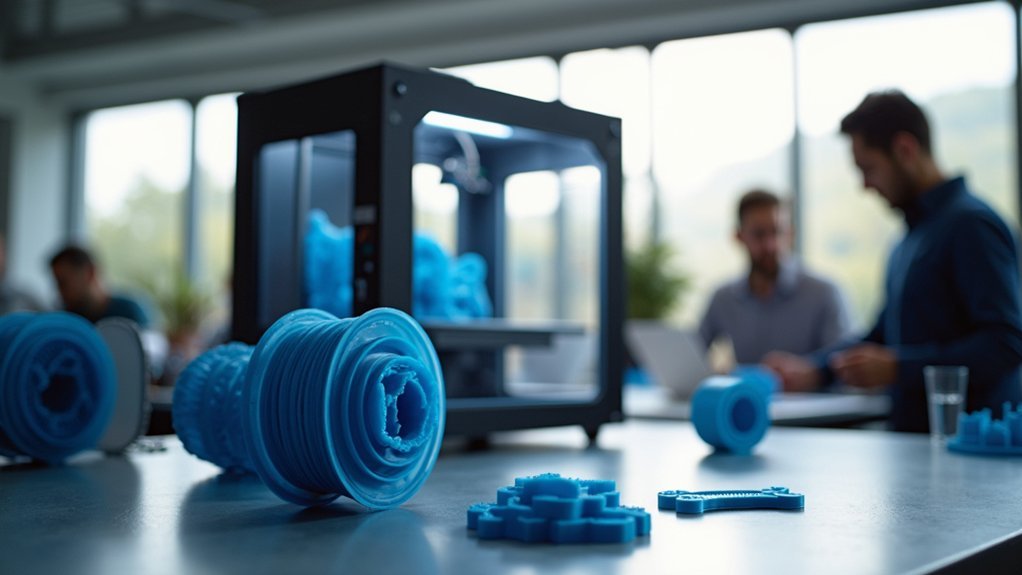
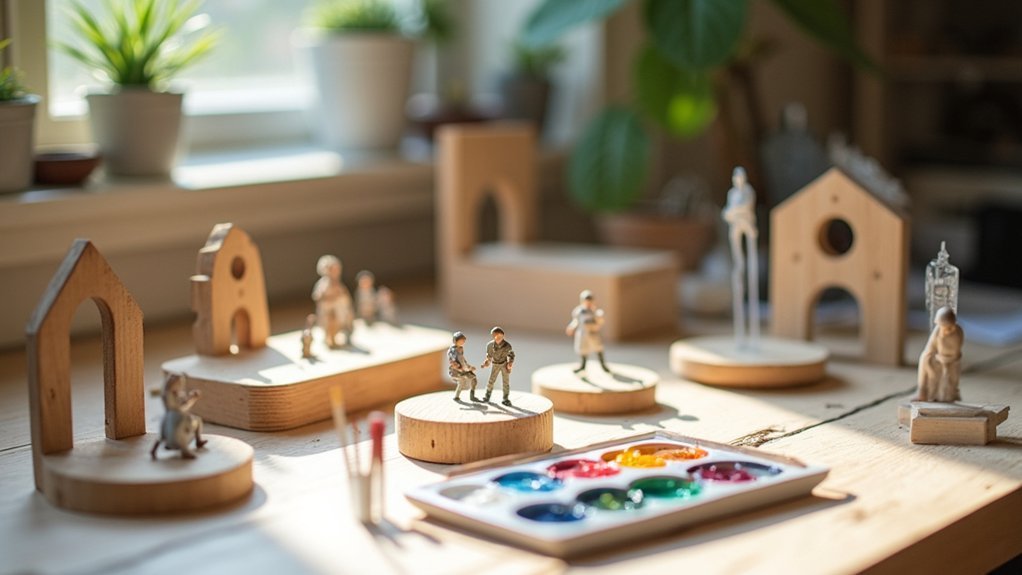


Leave a Reply